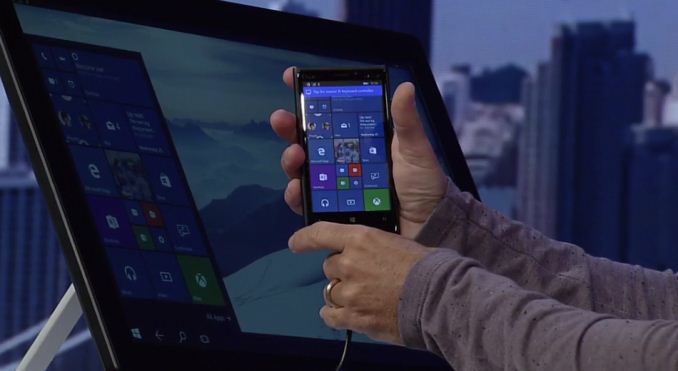Microsoft Shows Off Continuum For Windows 10 Phones
by Brandon Chester on April 29, 2015 2:57 PM EST- Posted in
- Microsoft
- BUILD
- Windows 10

Today Microsoft revealed a number of new features relating to their various platforms at their BUILD developer conference. One of the most interesting features shown was the Continuum feature of Windows 10 phones. Microsoft has previously shown off the ability for tablets to connect to larger screens and input peripherals to act as a computer, and they have now shown those same abilities working on a smartphone. This is possible because applications developed for Windows 10 will be universal applications that can scale from your phone, to your computer, to your television.
During the keynote a Windows 10 smartphone was shown connected to a large display via HDMI, as well as to a Bluetooth keyboard and mouse. This allowed the phone to essentially act as though it were a Windows 10 computer, with applications like PowerPoint and Excel scaling to use the same layout that you would see when running them on a normal desktop computer. This type of dynamic behavior extends from interface changes to input paradigm changes as well. Devices may change their preferred input mode or interface to suit the peripherals that are or are not attached to a device.
Continuum looks like it will be a very interesting feature. Users will have to wait some time to get their hands on it though, as it won't be available in the preview release of Windows 10 that is scheduled to come out tomorrow. Microsoft has created a short video to explain a bit more about Continuum on Windows 10 phones and the potential use cases that they see for it, and I've embedded that video above.










17 Comments
View All Comments
Manch - Wednesday, April 29, 2015 - link
This is what i have been hoping for when MS decided to unify everything. I hope these new phones will be running x86 hardware too.kpkp - Wednesday, April 29, 2015 - link
As soon as I saw that on the keynote I thought next MS phones will use Intel, but I am not sure they are far yet.This universal apps confuse me a bit, can a dev recompile a win32 / .NET app to run on ARM? There were no asterisks in the keynote :-)
jeffkibuule - Wednesday, April 29, 2015 - link
Phone will only run Universal apps I'm pretty sure.kpkp - Wednesday, April 29, 2015 - link
Now you can convert/recompile your win32 / .NET apps as universal, but I am not sure if the universality extends to the CPU architecture (I doubt it, but they made it look like it...).Alexvrb - Wednesday, April 29, 2015 - link
If you rebuild your win32 software and make a universal app (or basically just recompile it if it's already .NET), it can be designed to run on ARM or x86 and various form factors (with a little UI work). There's actually already a bunch of Universal Apps on the Store now that do this. The framework for that has been in use for a good while. In many cases (it's up to the devs) you can buy a game once and download it on multiple different devices (desktop, tablet, phone).The big new additions are the ability to (relatively easily) recompile older Win32 .NET code as well as most Android/iOS code.
Manch - Wednesday, April 29, 2015 - link
PCWorld had an article in March about an Atom X3 using an x86 core with a Mali GPU. ASUS is the only major vendor to pick it up though. I hope other major vendors do or even better MS puts out a surface phone and it does to Win Phones what the Surface did for Win Tablets.Schnydz - Thursday, April 30, 2015 - link
Yeah, I'm optimistic now more than ever for an MS Surface Phone running Intel. There is already news about Surface 4 being fanless. So the tech is getting there.lilmoe - Wednesday, April 29, 2015 - link
I believe they meant that Win32/.NET apps will be able to "utilize" the APIs and services available to Universal Apps in addition to being listed in the store.It was a bit confusing to me at first too.
Alexvrb - Wednesday, April 29, 2015 - link
That's up to the developers. It's not like you're using x86 assembly code in a .NET application. There's no reason you can't build a universal app using said existing code and have it up and running on multiple form factors and both x86 and ARM. They would have to do some UI work at a minimum, but it's not like they have to rewrite everything, the bulk of the code they can just recompile.mkozakewich - Thursday, April 30, 2015 - link
Nothing to do with Intel. A Universal app on the phone and on the desktop will actually be the exact same app, and all Universal apps are new and are built to run across different architectures. ARM phones and computers still won't have access to win32 binaries.Because there's no real difference between phone and desktop now, I'm hoping phones that use an Atom core will now be able to install win32 binaries like any other x86 computer. They still wouldn't work well on the small screen, though, until you plug it into a monitor.
This whole concept will fade away over time, as the old software is eventually eclipsed by the newer stuff. I'm having trouble getting Paint Shop Pro 6 to run, these days.